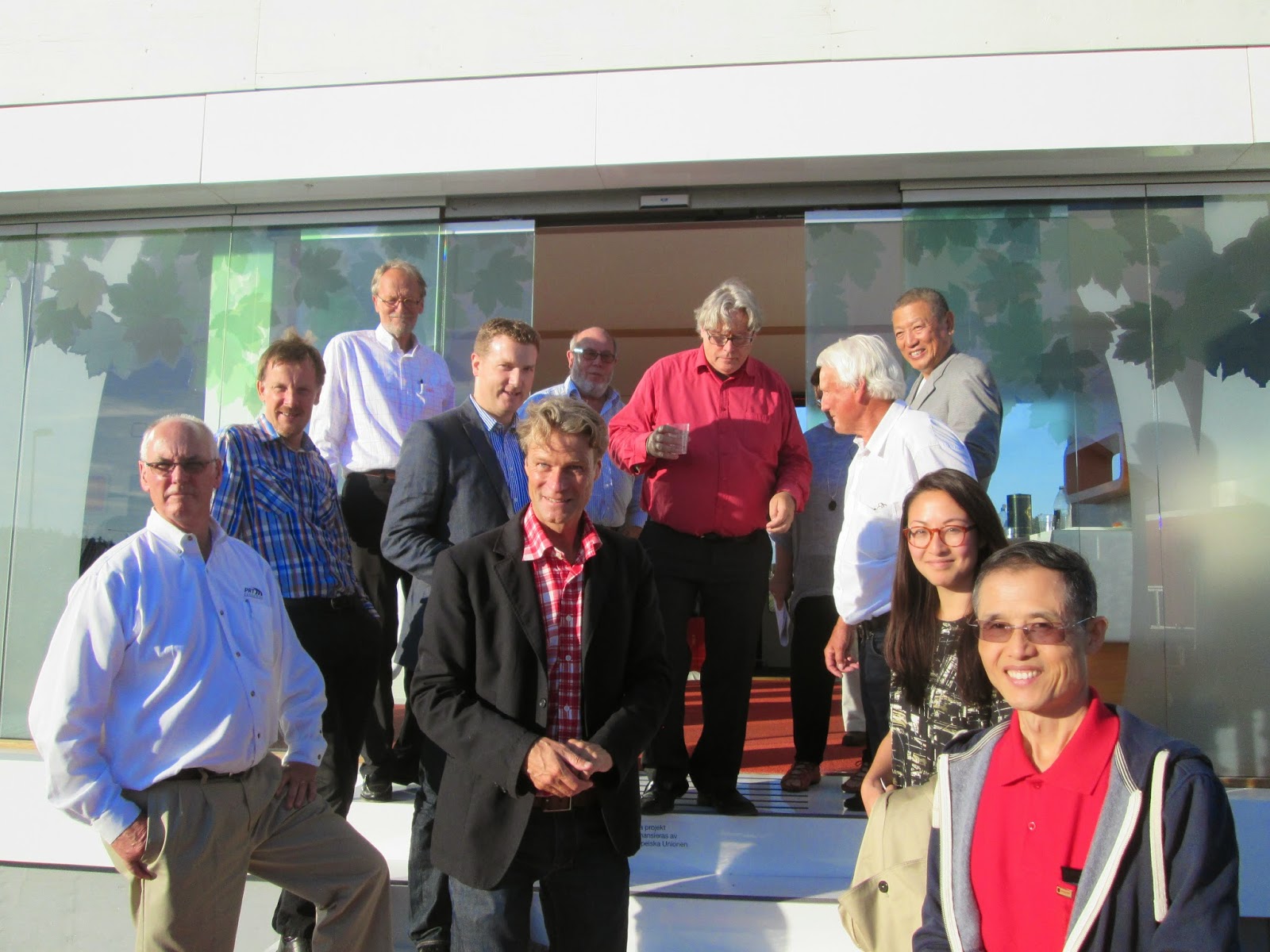The
8th Podcar City conference in Stockholm (Sept 3-5) emitted strong signs
that PRT (aka ATN, podcars, GRT and perhaps dual-mode systems) is now a
serious contender for urban transit implementations. As ride-sharing start-ups
garner big buck investments from even larger global Silicon Valley dynamos, it
seems that PRT is on the verge of getting long overdue public support and
private funds.
 |
| Magnus Hunhammar is in the center of the sun-kissed Icebreaker |
As
evident in plans for a huge Green activist march in New York City Sept 21-- timed
just before aUN Summit on Climate Change -- heightened interest in PRT is
coming from an urgent world search for ways to reduce carbon emissions. Themed
as To the next level!, PCC8 in Stockholm took podcar discussions to higher operational, financial and political levels. Bravo to chairman Magnus Hunhammar, director of the Institute for
Sustainable Transportation and to Hans Lindqvist, chair of the association of
Swedish municipalities moving to embrace PRT solutions, known as Kompass!
Modest
Implementations Within Reach
Discussions
at PCC8 excited many. One session previewed the newly released assessment of
the Automated Transit Network industry by San Jose State University’s
Mineta Transportation Institute. The USDOT report was internally and externally
reviewed, and includes a significant recommendation that ten-station PRT projects
are within technological reach. A live hook-up to San Jose with three of the research
team who were at PCC8 made this clear. The report is available at http://transweb.sjsu.edu/project/1227.html.
PRT
developers Ultra and Vectus were also actively present in
Stockholm in early September, along with several new Chinese entrepreneurs. The team from Tubenet impressed all with their future-embracing outlook and
Asia-scoped action plans. Swedish consultant Ingmar Andreasson wowed the largely
Swedish-US gathering with quantitative analysis indicating that PRT capacities
can be boosted to levels more comfortable for transit officials.
 |
| A Venue near Arlanda Airport |
Tubenet’s podcar design uses quite small vehicles that can operate at three “tiers” -- 40, 60
and 80 km/hr -- coming from a country where transit is in boom mode. Vehicles running within a tube have overhead power rail and solar collectors atop the tube. This Chinese R&D program is working on a 4km, 12-station test network running in 3 years based on
existing vehicle and guideway prototypes. A metro-wide 446km network has been
simulated for the ancient city of Xian (population. 4m).
No
one from France participated in PCC8. Podcar visionary Christer Lindstrom, whose French
mother taught him la belle langue, was perhaps the closest thing. France
prides itself on innovative transport and earns lots of foreign currency
planning, building and operation metros and bus systems. How triste that
no one from France or Germany seems to be paying attention to PRT potentialities
.
Political
Questions and Challenges
The
Swedish Transportation Administration’s Chief Strategist Bo Olsson is not and
cannot be a podcar “fan”. He must take an objective standpoint. At PCC8 he advised
that taxi-sized vehicles as typically envisioned for PRT are not necessarily
optimal for all urban mobility needs. Larger vehicles make good sense in thinking
out future modal priorities. Olsson also cautioned that PRT guideways are a
negative due to their costs and aesthetics.
The mainstream transit world - engineers, planners, contractors and
operators - is still largely dismissive of PRT. None of them were at PCC8. They are
busy with the worldwide metro boom which is increasingly driverless. By and
large, Swedish civic leaders think of PRT as “science fiction”. Their European
and American counterparts do too. The big difference is that in Sweden, officials
have a qualitative and quantitative grasp of PRT. In the US, they
hardly know what it is.
Crystallizing
Interest
Sweden’s sophistication with PRT is based on analysis
and simulations that offer dimensions to public discussions. Goran Tegner is a major leader in these
debates and pointed out that Stockholm transit ridership is stagnant. Andreasson’s new research indicates that PRT capacities
can be boosted by use of coupled, larger vehicles, each trip scheduled to 2 or
3 stations during peak hours. For a California city, a 48 km, 50-station
network can distribute 13,400 in an hour from a regional rail station (link
capacity 6000pphpd).
 |
| Ron Swenson in a Pod |
Dozens of Swedish
municipalities and institutions are working to advance PRT visions. Two new ones
popped in at PCC8 -- from Stockholm suburbs Sundbyberg and Botkyrka. Plans for
Uppsala were “frozen” last year, but are not dead. EU officials have asked why
an application for funds has not been submitted. Meanwhile this university town of 200,000 residents
is studying streetcar options.
Four
development nodes envisioned outside Stockholm’s growing Arlanda Airport are
showing broader and, in the long run, more financeable podcar ambitions. Major office
expansion of the airport’s Airport City, a successful segment of retail,
hotel and meeting facilities wedged between the main passenger terminals, is
underway. A PRT network connecting all this and the town of Marsta is widely
understood by airport and local officials to be a sustainable option that will reduce carbon emissions and make
the area more efficient and prosperous. This has been drafted into a report,
and a panel of four political candidates from different parties at PCC8 agreed
that it is worth pursuing.
Based
on these discussions, the maturation of the many aspects of PRT technologies
made over the last decade and the new USDOT report, PCC8 ended with a clear statement: public
officials can plan and implement better mobility options with confidence. And next year -- in San Jose?
